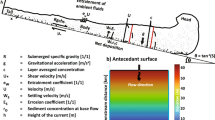Abstract
Many oil-bearing sedimentary deposits are formed by the settling of particles from turbidity currents. Modeling sedimentary processes that form these turbidites enables the calculation of properties such as extent, depth, porosity and permeability of hydrocarbon-bearing reservoirs. This paper estimates the extent and thickness of turbidites from the initial conditions of the turbidity flow. This is achieved by the application of scaling analysis of the partial differential equations that govern the dynamics of and deposition from turbidity currents. We apply the results of scaling analysis to five modern submarine fans. The predicted and actual values of the dimensions of the fan deposits match well. We then compare the derived results against tabulated sizes of ancient turbidites. The comparisons are good as long as we correctly identify the flow regimes in which the deposition took place. The good agreements observed in the two cases show that the estimates obtained using scaling analysis can provide useful first-guess values for the dimensions of the deposits.






Similar content being viewed by others
References
Bagnold RA (1962) Auto-suspension of transported sediment, turbidity currents. Proc R Soc Lond A 265:315–319
Bennetts KRW, Pilkey OH (1976) Characteristics of three turbidites, hispaniola-caicos basin. Geol Soc Am Bull 87:1291–1300
Bonnecaze RT, Lister JR (1999) Particle-driven gravity currents down planar slopes. J Fluid Mech 390:75–91
Bonnecaze RT, Huppert HE, Lister JR (1993) Particle-driven gravity currents. J Fluid Mech 250:339–369
Bonnecaze RT, Hallworth MA, Huppert HE, Lister JR (1995) Axisymmetric particle-driven gravity currents. J Fluid Mech 294:93–121
Bonnecaze RT, Huppert HE, Lister JR (1996) Patterns of sedimentation from polydispersed turbidity currents. Proc R Soc Lond 452:2247–2261
Bouma AH, Normark WR, Barnes NE (eds) (1985) Submarine fans and related turbidite systems. Springer, Berlin Heidelberg New York
Dade WB, Huppert HE (1994) Predicting the geometry of channelized deep-sea turbidites. Geology 22:645–648
Dade WB, Huppert HE (1995a) A box model for non-entraining, suspension-driven gravity surges on horizontal surfaces. Sedimentology 42:453–471
Dade WB, Huppert HE (1995b) Runout and fine-sediment deposits of axisymmetric turbidity currents. J Geophys Res 100 (C9):18597–18609
Ellison TH, Turner JS (1959) Turbulent entrainment in stratified flows. J Fluid Mech 6:423–448
Garcia MH (1994) Depositional turbidity currents laden with poorly sorted sediment. J Hydraul Eng 120:1240–1263
Hamlin S (1999) Syn-orogenic slope and basin depositional systems, ozona sandstone, Val Verde basin, southwest Texas. PhD Thesis, The University of Texas at Austin
Hogg AJ, Huppert HE, Hallworth MA (1999) Reversing buoyancy of particle-driven gravity currents. Phys Fluids 11:2891–2900
Middleton GV (1966) Small scale models of turbidity currents and the criterion for autosuspension. J Sediment Petrol 36:202–208
Middleton GV (1967) Experiments on density and turbidity currents. III. Deposition of sediment. Can J Earth Sci 4:475–505
Middleton GV, Neal WJ (1989) Experiments on the thickness of beds deposited by turbidity currents. J Sediment Petrol 59:297–307
Middleton GV, Southard JB (1984) Mechanics of sediment movement. Soc Econ Paleontol Mineral Short Course no 3
Parker G (1982) Conditions for the ignition of catastrophically erosive turbidity currents. J Fluid Mech 46:307–327
Parker G, Fukushima Y, Pantin HM (1986) Self-accelerating turbidity currents. J Fluid Mech 171:145–181
Parker G, Garcia MH, Fukushima Y, Yu W (1987) Experiments on turbidity currents over an erodible bed. J Hydr Res 25:123–147
Shook M, Li D, Lake LW (1992) Scaling immiscible flow through permeable media by inspectional analysis. In Situ 16:311–349
Sparks RSJ, Bonnecaze RT, Huppert HE, Lister JR, Mader H, Phillips J (1993) Sediment-laden gravity currents with reversing buoyancy. Earth Planet Sci Lett 114:243–257
Walker RG (1992) Turbidites and submarine fans. In: Walker RG, James NP (eds) Facies models—Response to sea level change. Geological Association of Canada, St John’s, Nfld, pp 239–263
Whitaker S (1968) Introduction to fluid mechanics. Prentice-Hall, Englewood Cliffs, NJ
Acknowledgements
This work was supported by a grant from the Mobil Strategic Research Center. Larry W. Lake holds the W.A. (Monty) Moncrief Centennial Chair at The University of Texas.
Author information
Authors and Affiliations
Corresponding author
Rights and permissions
About this article
Cite this article
Srivatsan, L., Lake, L.W. & Bonnecaze, R.T. Scaling analysis of deposition from turbidity currents. Geo-Mar Lett 24, 63–74 (2004). https://doi.org/10.1007/s00367-003-0162-x
Received:
Accepted:
Published:
Issue Date:
DOI: https://doi.org/10.1007/s00367-003-0162-x




